Can hand signs signal disease & psychiatric disorders?
August 24, 2011
Long ago the hands were discovered as a diagnostic tool, and therefore it is not surprizing that many great philosophers have described the significance of hands! Today hands can be used as a diagnostic instrument in order to recognize various medical & psychiatric disorders, such as: schizophrenia, diabetes mellitus, psoriasis, rheumatoid arthritis, Marfan syndrome, fragile-x syndrome & Down syndrome. How come?
A few quotes from respected philosophers describing the philosophical importance of hands:

Aristotle (384BC - 322BC)
“… (the hand) is the organ of the organs, the active agent of the passive powers”

Sir Charles Bell (1774-1842).
“The hand is essentially the organ of the mind, the medium of its expression, and the Instrument whereby its promptings are carried into execution”

Carl Gustav Jung (1875-1961).
Carl Gust Jung, the Swiss psychiatrist said:
“Chirology [hand reading] is an art which dates back to very ancient times. The ancient physician never hesitated to make use of such
auxiliary systems as chiromancy and astrology for diagnostic and prognostic purposes as is shown, for instance, by the book of Dr. Goclenius who lived at the end of the sixteenth century. … The totality-conception of modern biology which is based on the evidence of a host of observations and research does not exclude the possibility that hands, whose shape and functioning are so intimately connected with the psyche, might provide revealing and therefore, interpretable expressions of psychical peculiarity, that is, of the human character. …”
Today, the hand can be used to study the significance of hand signs in the perspective of quite a few syndromes, diseases, and psychiatric disorders. You can check out many more details about dozens of hand signs via the sources below:
• 34 Hand signs in Diabetes Mellitus (type 1 & 2)
• 29 Hand signs in Down syndrome (trisomy 21)
• 30 Hands signs in Fragile-X syndrome
• 5 Hand signs in Marfan syndrome
• 24 Hand signs in Psoriasis
• 28 Hand signs in Rheumatoid Arthritis
• 37 Hand signs in Schizophrenia
HANDS & DOWN SYNDROME – A Simian Crease Poll!
May 15, 2011

The BabyCenter.com has conducted a simian crease poll among parents of children who have Down syndrome.
The result confirms the significance of the simian line in Down syndrome, because 41 of the 95 participants (=43%) reported that their child has Down’s syndrome.
But the diagnostic signficance of a simian crease (simian line) is unspecific. Despite the fact that the simian crease is well-known for it’s significance in children & adults who have Down syndrome – there are quite a few other syndromes which show even higher percentages regarding the occurence of the simian crease, such as: the cat-cry syndrome, Edwards syndrome, Patau syndrome, and Cornelia de Lange syndrome.
The most common synonyms for the simian crease are: simian line, single transverse crease, single palmar crease
Read more about the role of the simian crease in Multi-Perspective Palm Reading:
http://www.multiperspectivepalmreading.com/palm-reading-hand-creases-major-lines.htm
Hand shape varies between the two sexes: males typically have larger, relatively broader hands, while females typically have smaller, relatively narrower hands. But hand shape also varies among the various populations around the world: in Asia the avarage hand shape is relatively narrower than in European & North American countries. And there is even a link between hand shape & intelligence!
But in order to understand these patterns properly, one first has to understand the relations ship between hand shape & body length. Because in general, all longer populations in the world (males, Europeans & North Americans) typically display a relatively broad hand shape, while all small populations (females, Asians) typically display a relatively narrow hand shape.
–
HAND INDEX:

A good measure to describe the shape of the hand is the so-called ‘hand index’, which is defined as the ratio between the ‘hand width’ (= palm width measured at the metacapals) vs. the ‘hand length’ (= the distance between the tip of the middle finger and the distal wrist crease).
The average ‘hand index’ in human kind is close to 0.44, and is typically much higher than the ‘hand index’ seen in primates, which is typically (far) below 0.40 (though in gorillas – the largest of all primate species – the ‘hand index’ is higher than 0.40).
NOTICE: Finger length can also be measured relative to ‘hand length’ & ‘hand width’, but that topic will be discussed later.
–

HAND SHAPE & SEXE:
In males the ‘hand index’ is typically higher than 0.44, and measures above 0.45 are often seen. While in females the ‘hand index’ is typically lower than 0.44, and measures below 0.43 are not rare at all. These sexe differences are for a large part the result of the body height differences between males and females.
HAND SHAPE & RACE:
The average ‘hand index’ among the various races differs significantly, and is typically lower among asians. In people from China does not vary a lot from the average of human kind, but among for example people from Japan & India the ‘hand index’ is typically close to 0.43 or even lower. At least partly these differences are explained by racial differences in body height.
HAND SHAPE & IQ:
A high hand index typically correlates with a low IQ. And this link between hand shape & IQ has been confirmed in quite a few studies among various types of populations.
In a 1980 study in the former Yugoslavia reported among 540 men a negative correlation between hand index & all 10 measures for IQ.
And the two most common causes for mental retardation (Down syndrome & fragile-X syndrome) are known for having typically a relatively broad hand (= high hand index).
Regarding the sexe differences, one has to be aware of the earlier mentioned point that tall populations typically have a higher ‘hand index’. The fact that women have a lower ‘hand index’ compared to men, is largely neutralized by the fact that women are smaller than men. And therefore there one should not associate this sexe difference with IQ differences among the sexes (because so far there is no evidence for that at all).
And finally there is evidence that when the ‘hand index’ is corrected for body height, then this appears to explain a significant part of the IQ differences that are typically seen between the nations of the world. Though this issue has not been studied thoroughly.
HIGH OR LOW ‘HAND INDEX’ IN INDIVUALS:
The above describes patterns for hand shape implicate that regarding the implications of a high or low ‘hand index’ indivuals, one always has to consider sexe & race before jumping into conclusions!
Time for a hand shape palm reading… what is your ‘hand index’?

HANDS & IQ – How to recognize a smart hand: 2 – the AtD-angle!
January 18, 2011
Most people are aware that they have fingerprints. But few people are aware of the likewise dermatoglyphic features in their palms. One of the most interesting characteristics of the palmar dermatoglyphics concerns the so-called AtD-angle: which concerns the angle between the a- triradius (under the index finger), the axial triradius (near the wrist), and the d-triradius (under the pinky finger).
 Interestingly, beyond the trisomy studies, a few other studies have indicated that the AtD-angle provides a significant clue about intelligence.
Interestingly, beyond the trisomy studies, a few other studies have indicated that the AtD-angle provides a significant clue about intelligence.A 2010 STUDY:
A 1980 STUDY:

HANDS & IQ – How to recognize a smart hand: 1 – hand shape!
January 10, 2011

Just another concept of how various types IQ could relate to the fingers...?
The previous post introduced Dermatoglyphics Multiple Intelligence Test (DMIT) – which e.g. describes how various aspects of intelligence could relate to the 10 individual fingers & the brain lobes. Unfortunately there appears to be no (academic) scientific evidence available which confirms the validity of the DMIT-model. But there appears to be multiple evidence available which does confirm that various hand features do provide clues to the general intelligence – specified to the intelligence quotient (IQ)!
In the next 3 posts a quick introduction to how various hand dimensions correlate with IQ, starting with: hand shape.
• HAND SHAPE & IQ:
The two most common causes of a mental retardation (Down syndrome + fragile X-sydrome) are typically featured with relatively broad palm. This typically results in a high ‘hand index’: > 47.
NOTICE: The ‘hand index’ is defined as: 100 x the quotient of the palm width and the hand length. A ‘hand index’ of 0.47 or higher could be described as high, because far most international ‘hand index’ studies so far indicate that the average varies from 42 to 0.46 (Japanese males: 43.1, American males: 46; Japanese females: 42.3, American females: 43.7).
So, one could expect that a low ‘hand index’ could provide a clue to a high IQ. But one should be very aware of the fact that the ‘hand index’ varies among men (higher) and women (lower), and among ethnic populations (lower in asians, higher in caucasians).
Interestingly… a 1980 Zagreb study on a large sample of males (N=540) has pointed out that ‘hand width’ does correlate negative with IQ (confirmed at all 10 IQ measures involved in the study). The study also reported that ‘hand length’ did not correlate with IQ – some of the dimensions produced very small positive correlations, which raises the question whether ‘hand index’ would have produced more signficant results than ‘hand width’.
NOTICE: The 1980 study also reveal that all 10 IQ measures produced positive correlations which ‘body height’ – a result which has been confirmed by many studies.
The picture below demonstrates how to measure ‘hand width’: in scientific studies this is always done at the position of the metacarpals (0ne could use the starting point of the life line as an easy identifyable point of reference).
And hand length is measure from the distal wrist crease to the tip of the middle finger.

  
• Tribute to the hands of Thom Yorke! Thom Yorke thumbs & the simian line… The simian line (a.k.a. ‘simian crease’) is the most studied line of the human hand. Despite it’s associations with Down syndrome (+ a rainbow of other medical problems), quite a few famous people have the simian line. Radiohead’s leadsinger Thom York has a variant of the classic simian line in his right hand – an ‘incomplete simian crease‘. What do we know about the most ‘notorious’ of all hand lines? Having a simian line is not very uncommon at all: about 2% to 4% of the population has this rather remarkable hand line – though in Asia the percentages are higher up to above 10% in Chinese people. Rather remarkable – despite the strong links with various medical problems – some believe that the simian line can also be recognized as a ‘gift marker‘ which could relate to strong personality characteristics that bring stamina, intensity and strong concentration. More Thom Yorke thumbs of his simian line:
– MORE FAMOUS HANDS & THUMBS – Another fascinating characteristic of the hands of Thom Yorke concerns his fingerlength: his ring finger is much longer than his pointer finger. Interestingly the long ring finger has historically been associated with musical abilities. Professor John Manning (Liverpool University) presented in 2000 a study which pointed out that the hands of male symphony musicians are characterised with a likewise combination: the low ‘digit ratio’ – of 2D:4D finger ratio (2D = index finger; 4D = ring finger). Quote from Professor John T. Manning’s book ‘digit ratio’ (page 121):
By the way, extreme digit ratios (finger lengths) are – just like the ‘simian crease’ (Thom Yorke) and the ‘clubbed thumb’ (Megan Fox) – recognized as a ‘minor physical anomaly’ (MPA). SUGGESTION FOR FURTHER READING: |
DOWN SYNDROME – 27 Characteristics of the hand in trisomy 21!
January 19, 2010

Phantom picture of the hand in Down syndrome! In 1963 L.S. Penrose presented the first ‘phantom picture’ describing the typical hand characteristics in Down syndrome. More detailed ‘phantom pictures’ were presented by Schaumann & Alter (1976), Rodewald (1981). This month (2010) a more detailed updated version of the visualisation became available – featuring 27 characteristics of the hand in Down’s syndrome! What are the most common hand characteristics in Down syndrome? HAND LINES: DERMATOGLYPHICS: HAND SHAPE: NOTICE: The author of the new ‘phantom picture’ for Down syndrome described a specific guideline which states that in all cases of Down syndrome certain combinations of the 27 characteristics are found in both the fingers AND the palm of the hand! More details available at: Photo: example of a baby hand in Down syndrome
|
The ‘hypothenar whorl’ – a characteristic in schizophrenia, Down syndrome… and autism?
October 12, 2009
|
New research links the ‘Moon whorl’ with autism! (On top of Down syndrome & schizophrenia) In 1892, Sir Francis Galton published his highly influential book, ‘Finger Prints’ in which he described his classification system based on the number of triradii. On of the 3 most well-known fingerprint types is the ‘whorl’ (next to the ‘loop’ and ‘arch’), which is often found on the fingertips – but rarely found on the hypothenar (in palistry: ‘mount of Moon’)! What was already known about the ‘hypothenar whorl’? Quote from the article:
NEW RESEARCH FINDING ON AUTISM! Another quote from the article:
Some examples of the ‘hypothenar composite whorl’ are presented below. In the perspective of the fact that in the science of fingerprints the ‘composite whorl’ is related to the ‘double loop’, it is interesting to notice here that the new finding relates to an earlier reported finding which pointed out that the hands of people with autism are often featured with a ‘double loop’ in the fingerprint of the pinky finger and the presence of 2 palmar loops below that 5th finger. In cases you’re interested to learn more about the basics of fingerprint classification – the illustration below describes the 8 most common types of fingerprints (including: 2 ‘arch’ variants, 2 ‘loop’ variants, and 4 ‘whorl’ variants). NOTICE: The ‘composite whorl’ whorl does not belong to the 8 basic fingerprint types (the name ‘double loop whorl’ in the picture below is traditionally described as a ‘double loop’).
SUGGESTION FOR FURTHER READING: • How fingerprinting works! |



 “Sorell (1968) pointed out that musical ability has been linked with very long ring fingers for many years. He illustrated this with handprints from composers such as Alexander Tcherpenin and Edgar Varese, but the most powerful image he showed in this context was that of a cast of
“Sorell (1968) pointed out that musical ability has been linked with very long ring fingers for many years. He illustrated this with handprints from composers such as Alexander Tcherpenin and Edgar Varese, but the most powerful image he showed in this context was that of a cast of 

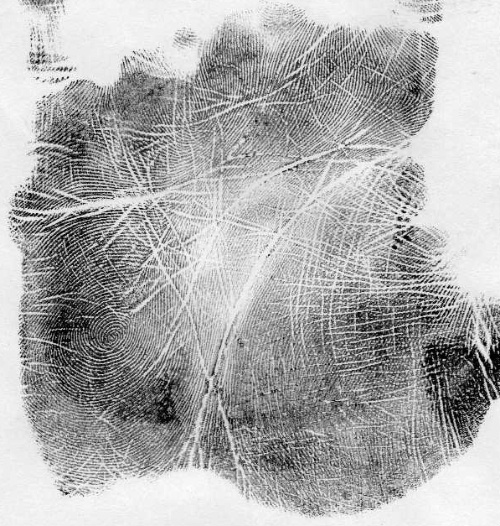
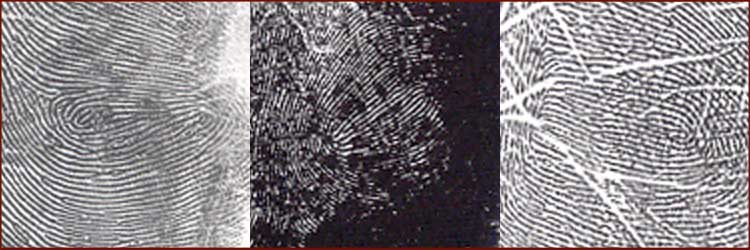

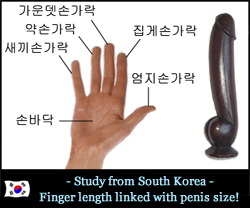 Finger length & penis size linked!
Finger length & penis size linked!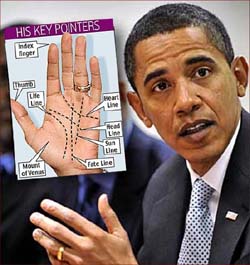 The hands of Barack Obama
The hands of Barack Obama Megan Fox thumbs – TRIBUTE
Megan Fox thumbs – TRIBUTE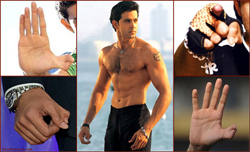 Hrithik Roshan thumbs – TRIBUTE
Hrithik Roshan thumbs – TRIBUTE Hand Reading Research!
Hand Reading Research! MultiPerspective Palm Reading
MultiPerspective Palm Reading